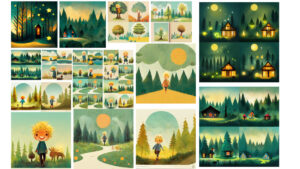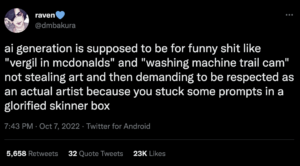

Different artists’ opinions on how AI art should be used
HumberVisual arts Oct 12, 2022 Thalia Nualda

Digital technology evolves continuously over time. The first computer invention in 1937, which was used to solve systems of linear equations, has evolved to computers that can be used for anything other than solving equations. Artificial Intelligence art was first used in 1973 when a program was developed where it generated art based on rules set by the developer.
Criticism always either comes from a subjective perspective or an objective perspective, where one pair of eyes could say the art is beautiful while another set of eyes could say the opposite. This does not only apply to painting or digital painting but the arts in general.
Ebru Kur is a second-year Visual and Digital Arts student who says the art world has always been subjective about what’s considered beautiful and what is considered art.
“Most artists use other artists’ works with knowing or without knowing. I’m going to give an example, Mona Lisa. People have been using Mona Lisa for more than 100 years and they’re creating different types of Mona Lisa in their own creations,” Kur says.
Kur uses AI with her mood boards, however, she never used AI art for her final products. She only uses AI art to help her start her projects as she believes the AI generator art is still not in the perfect condition to be used in her final products.
Kur says AI art is still at the threshold as everyone is still figuring it out without plagiarizing any artists before claiming the art is theirs. AI art has still a long way to go in terms of copyright issues. The first copyrighted AI-generated art through the United States Copyright Office (USCO) only happened last Sept. 20. Meanwhile, Canada has given someone their copyright registration for their AI-generated art.
Kur is currently working on her school projects, such as an illustration book about domestic violence survivors and an abstract art about memories and urban landscapes. She says her domestic violence survivors illustration book is volunteer work for her Special Topics in Contemporary Practice class.
Text-to-image AI art has been popularized since there was a trend on TikTok. The trend allowed people to enter their birthdays and an AI or a filter would generate random art in the background. Adding to that, an AI art won first place at the Colorado State Fair. Jason Allen, winner of the Colorado State Fair, used a program called MidJourney for his work and celebrated his win in the MidJourney’s discord server. Allen, however, received some harsh backlash from Twitter.
Despite the backlash, Adrianne Jung, also known as A.R. Jung, is a graphic illustrator, author, and educator who recently ventured into AI art. She has written and published a children’s book in 2019 and is currently experimenting with how to use different software for her AI arts.
“I’m trying to look at all of this as an opportunity to learn something and then to create a niche that way. Instead of getting bogged down in ‘this isn’t fair’ and stuff like that. Sometimes as an artist, you have to find where you can express yourself and I feel good right here. So, I’m trying not to get bogged down,” Jung said.
Jung says there are a lot of things happening in the literary world as well and having a voice in these matters is “super important.” She has a background in graphic design and says even if she did not continue with her degree, she still practiced art through writing. Jung says AI art requires a lot of knowledge about technology.
“We’re all contributing right now to the AI learning these skills, like all of our input [are] teaching that the bigger brain knows how to do it on its own. I just think it’s really cool and you need to be able to adapt and change your art to fit what’s going on,” Jung said.
Jung says her art is “very conceptual” as she based it on art history, especially Art Nouveau. She learned about AI art due to a study she was part of. She said her art advanced quickly because of her knowledge of graphic design, which was when she was able to do more advanced leaps and bounds on what her art was going to look like visually. She hopes her AI skills develop enough that she can do book layouts and get paid for her art, she is currently looking into contract work as she wants to continue working on her skills more consistently.
Esther Luntadilla is a digital artist based in the GTA who wants to represent Bratz dolls and Black girls through her art style. She also does a lot of glossy artwork as seen on her Instagram page.
Luntadilla says through this new technology would also help people discover more new artists, although AI art doesn’t appeal to her. She feels like it is just a bunch of images put together and there is no clarity in it. On the other hand, despite the availability of AI software, she doesn’t see the need of using AI for her artwork or her work in general.
“I started with traditional art and I realized it was more expensive to draw on paper because you have to buy sketchbooks and you have to buy the paint, it was just too much you have to buy the canvas and everything so I discovered digital art,” Luntadilla said.
It was easy for her to share and sell her work to anybody in the world if she did digital art. She sells framed physical copies of her artwork as well but she leans more toward the digital side of selling her artwork. Other than her artwork, she also sells digital colouring books because according to her, having a digital colouring book is easier than having a physical copy of it.
As of right now, Luntadilla is focusing on expanding her brand into physical products, such as hoodies, hats, keychains, and a physical colouring book. She wants to cater more to her older audiences who want to feel that “paper-pencil feel” when using a colouring book.
The subjectivity of art will always be present from different opinions on how AI art should be used. Some people find it as a form of art, others think it’s unethical. People’s taste in art can change over time, just as technology inevitably continues to advance.








